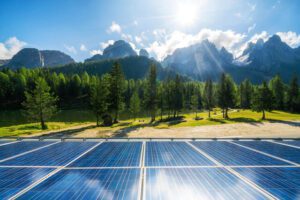Spend five minutes on Google and you’ll find news on the plummeting cost of solar energy. And while wind electricity contracts are falling, solar installations are setting record-low prices for renewables multiple times a year.
Why is solar stepping into the limelight?
To start, the cost of clean energy technology breaks down per megawatt hour of electricity generated. Nearly all of wind energy’s cost comes from physical components of the turbine and infrastructure — towers, blades, gearbox, concrete pad, etc.
Whereas for solar, the costs are spread across multiple elements. This includes sales expenses, business operations, racking and installation, and, of course, the photovoltaic (PV) panels themselves. If costs fall because of innovation and efficiencies, solar as a business can react and evolve in more ways than wind.
In the Baltic Sea off the coast of Denmark, for example, the Kriegers Flak wind farm set the lowest offshore wind price at US$54 per megawatt-hour (MWh). Around the same time, onshore wind was frequently found for prices below $45/MWh.
On the solar front, in comparison, a Dubai auction in May 2016 broke records with a $29.90/MWh price. Mere weeks later, a 120 MW solar plant in Chile lowered the ante to $29.10/MWh. When the second half of 2016 rolled around, a tender in Abu Dhabi saw a price of $24.20/MWh, bringing the record-low trophy back to the United Arab Emirates. There is talk now of a Saudi Arabian strike price lower than $20/MWh to be announced in the next few months.
This graph illustrates solar cost inputs over time.
Source: Deutche Bank and SE Global Research and Analytics
The prices of these utility-scale solar projects aren’t the only thing that’s surprising; it’s the continued speed at which costs are plummeting. It was a little more than a year ago that wind farms provided the best renewable deals around. But then some substantial changes in the solar industry gave the panel an edge.
One of the most noteworthy is installation costs. Even though these fees increased as a percentage of total project costs from 2014 to 2017, actual prices fell from 65 cents per watt to 45 cents per watt. In fact, all of the components of a solar transaction saw similar declines, not just the “soft costs” of sales, marketing and installation.
This graph illustrates the solar cost inputs as a percentage of total price.
Source: Schneider Electric Global Research & Analytics and Deutche Bank
Because the upfront capital costs of wind generation are almost exclusively tied to the turbine and infrastructure, advances come in size and scale of the hardware. So wind blades are getting longer and towers taller, capturing more stable wind speeds that reside higher in the atmosphere. However, there are natural limitations to length and height. Further aerodynamic innovation is limited.
That brings the conversation from the past and present to the future. In the end, the dynamics of the wind industry dictate that the single most important variable for global prices is location. If the wind blows regularly and strong, then that site will provide low-cost wind energy.
The same correlation is not necessarily true for solar. Since labor costs vary across the world, these and other expenses combined with solar irradiation determine the best-value sites. Developing markets will have as much of an advantage as sunny places going forward.
For more information on international renewable energy opportunities, contact an energy markets expert.



